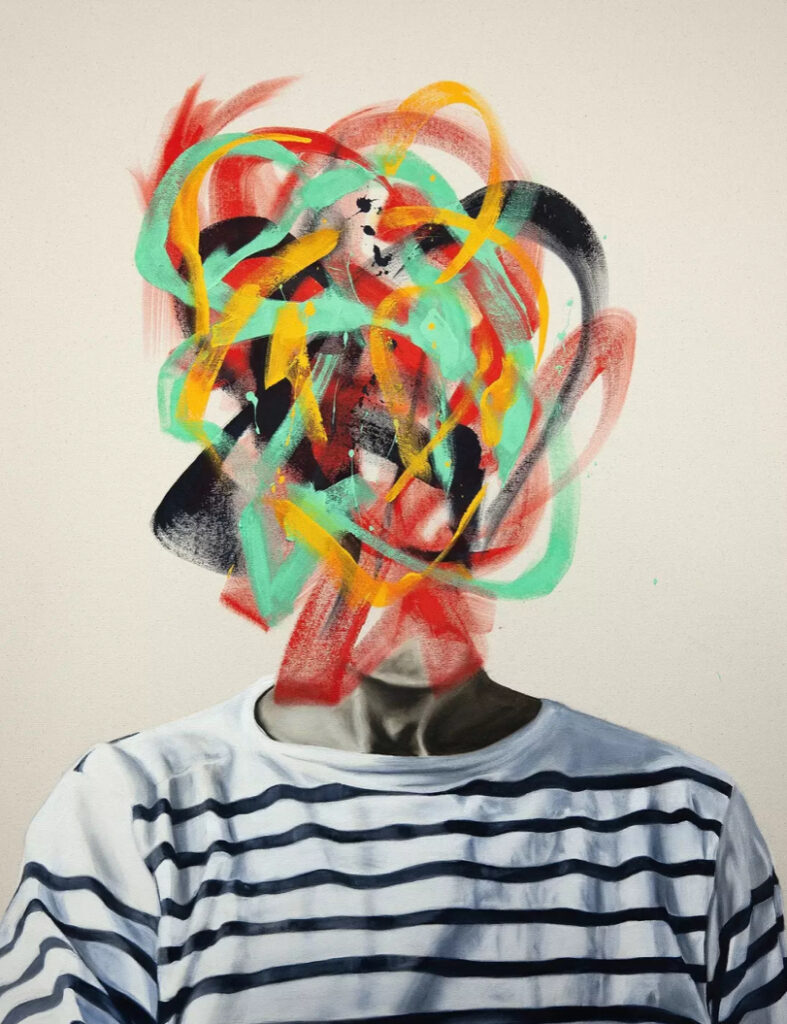
At first glance, Abstract Head No. 5 by Gregory Malphurs seems to resist interpretation. It refuses narrative. It recoils from realism. But step closer—linger in its silence—and a language begins to form: one composed of color, edge, and weighted gesture. This is not a portrait in the traditional sense. There are no eyes to return your gaze, no smile to decode, no direct identity to fix upon. And yet the work thrums with psychological specificity. It is, unmistakably, a head. But whose? And why does it look like this?
In Abstract Head No. 5, Malphurs constructs an image that challenges the conventions of portraiture, dissolving the figure into an emotionally charged landscape of contour and chromatic atmosphere. It is part of a larger series exploring fragmented identity, psychological residue, and the blurred boundaries between presence and perception. But this fifth entry stands apart—more austere, more compressed, more exacting in its instability.
What he delivers here is not a face, but a state of mind made visible.
The Anatomy of Distortion
The composition adheres loosely to the geometry of a head—an oblong shape hovers centrally, crowned by a weighty form that could be interpreted as hair or shadow. Inside the head’s outline: gestures. Brushstrokes thick and hesitant. Lines that echo the jawline or a furrowed brow, only to dissolve mid-thought. The facial structure seems held together by tension rather than anatomy, and yet, it communicates.
There is no mouth, but there is expression. No pupils, but a palpable stare. The psychological intensity lies not in likeness but in gesture—in the vibrating ambiguity between suggestion and erasure.
Malphurs wields distortion with purpose. He is not aiming for shock or surrealism. Rather, distortion becomes a form of emotional realism—a strategy to express the unspeakable conditions of modern identity: alienation, memory, displacement, and interior fragmentation. The viewer does not see a person, but rather feels a presence—obscured, incomplete, but deeply human.
Chromatic Language: The Hue of Thought
Color in Abstract Head No. 5 is not ornamental—it’s structural. It creates psychological weight and spatial paradox. Malphurs’ palette is at once limited and infinite. We see tones of maroon, ochre, slate grey, muted plum, and sickly greens. These colors do not radiate. They seep, bruise, and murmur.
There is no chromatic harmony in the classical sense. Instead, color operates as temperature, pressure, and friction. One side of the head may be bathed in a smear of umber, like a burn mark or a shadowed memory, while the other pulses faintly with lilac, as though some hope remains—or is being extinguished.
The background, often treated as afterthought in conventional portraiture, becomes essential in Malphurs’ treatment. It is not “negative space” but ambient emotion, responding to the figure like water to a submerged form. The line between figure and ground blurs. The head is emerging from or dissolving into its surroundings.
Technique: The Hand and Its Hesitation
What defines Malphurs’ process is his command of gesture and interruption. He lays down broad brushwork with conviction but often allows hesitation to interrupt momentum. Drips remain. Edges fray. Scratches slice through surfaces like thoughts breaking through language. There are areas where the paint is so thick it resembles skin, and others so thin it becomes veil-like.
This technique reflects a tension between construction and erosion, as though the artist is building an identity and simultaneously erasing it. In many ways, Abstract Head No. 5 feels unfinished. But this “unfinishedness” is its philosophy. It reflects the transitional nature of the self, the liminality of psychological form. The viewer confronts a being in process—mid-transformation or mid-dissolution.
There is no hierarchy of mark. Malphurs elevates the smudge and the stroke to equal footing. Even the canvas edges, typically sites of compositional termination, appear activated, suggesting the form wants to escape containment.
The Historical Lineage: Echoes and Departures
Malphurs doesn’t work in a vacuum. Abstract Head No. 5 reverberates with art historical ancestry, even as it carves its own language.
- The disfigured faces of Francis Bacon, with their raw psychic screams and claustrophobic rooms, seem like spiritual cousins. Yet Malphurs is subtler—his violence is interiorized, his distortion more withheld.
- One hears echoes of Paul Klee’s emotive abstraction, where color becomes code and identity a shape-shifting symbol.
- The formal economy recalls Alberto Giacometti, not in sculpture but in existential essence—a feeling of the self fading even as it insists on being seen.
Yet Malphurs diverges sharply from these influences in his restraint. Where others magnify horror or grotesquerie, Malphurs remains introspective. His work is not a scream but a long-held breath. Not confession, but quiet exposure.
Psychological Space: The Inner Room
To look at Abstract Head No. 5 is to enter a room inside someone else’s mind. The head becomes a container—not of knowledge, but of uncertainty. It is unclear whether this is a memory of a person or a person remembering themselves. The ambiguity is purposeful.
In many ways, Malphurs’ work speaks to the experience of living in a fragmented culture—a time when identity is performance, memory is corrupted by screens, and stillness is suspect. This head—unsure of its contours, dissolving into the background—becomes a mirror for our own psychological states.
And yet, despite its abstraction, the image feels intensely specific. Like a dream you can’t explain but know was real.
Viewer’s Dilemma: Empathy Without Clarity
One of the central powers of Abstract Head No. 5 is its ability to evoke empathy without clarity. We do not know who this figure is. We do not know their gender, race, age, or mood with certainty. And yet, we feel for them.
Malphurs manipulates form and ambiguity to create a paradox of recognition. We don’t need to “identify” with the figure to care about it. We feel its turmoil, its precarious presence, its almost-disappearance. That affective weight becomes more powerful than narrative backstory. This is a portrait of human condition, not a human individual.
Culture: Head in a Crisis
In our current socio-cultural moment, the motif of the head takes on new resonance. It is the site of conflict—between reason and emotion, memory and presentness, identity and anonymity.
Malphurs seems to understand this. His “head” is not a symbol of mastery or intellect, but of fragility, complexity, and emotional overload. It’s a symbol of the invisible wounds carried inside: depression, grief, disassociation, anxiety. It visualizes what we are often too ashamed to articulate.
In this way, Abstract Head No. 5 becomes a kind of visual therapy. Not a solution, but a space to recognize internal architecture—to feel seen in our unseen states.
Flow
Malphurs does not offer answers in Abstract Head No. 5. He does not ask the viewer to understand the figure, only to witness it. This refusal to resolve becomes an ethical gesture. In a world saturated by noise, speed, and certainty, ambiguity becomes a form of resistance.
The painting doesn’t want to be posted, simplified, memed, or explained. It wants to sit—uncomfortable, unresolved, and human. It demands time, patience, attention.
And in return, it offers something rare: a space to contemplate the self without pretense.
Thoughts
Gregory Malphurs’ Abstract Head No. 5 is a haunting and revelatory work. It engages with the head not as icon or identity badge, but as a site of collapse and construction. It denies us certainty while offering us emotion. It abandons likeness while preserving intimacy. It is a painting that stares at you, not because it has eyes, but because you are reflected in its refusal to be whole.
In a time when identity is increasingly packaged, optimized, and branded, Abstract Head No. 5 stands defiantly still—blurred, bruised, and profoundly honest. It doesn’t ask you to understand it. It only asks that you stay long enough to feel its weight.
No comments yet.








